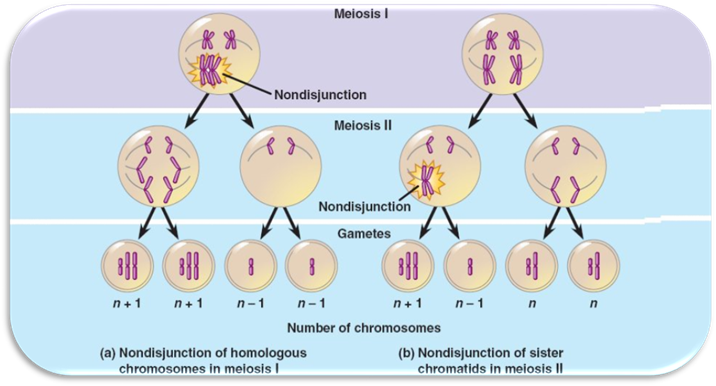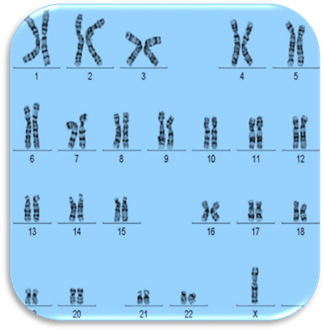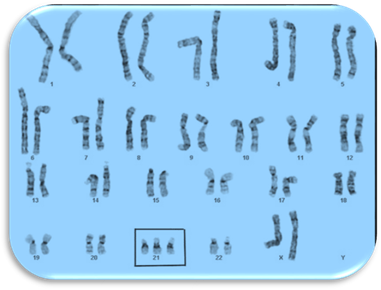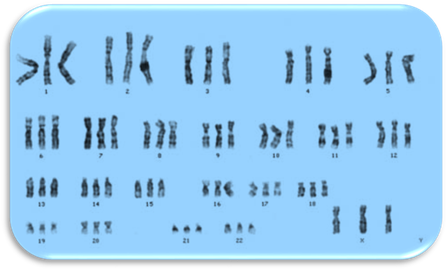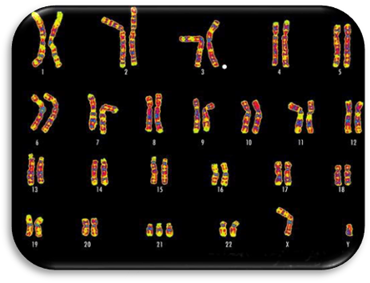
CHROMOSOMAL
DISORDERS
You have just learned what makes up chromosomes, and
how chromosomes divide to make gametes (through meiosis) and body (somatic)
cells (through mitosis). You will now look at problems that may occur in the
chromosomes during the division process and how these problems affect
individuals.
A mutation
is any change in the structure or amount of genetic material. In other words, a
mutation is any change in the DNA of a cell. Now we will look at some types of
chromosomal mutations.
|
Quick
Review |
|
To fully understand the mutations
that will be discussed, a good understanding of previous vocabulary is
needed. |
|
Chromosome Chromosomes
are thread-like structures located inside the nucleus of animal and plant
cells. Each chromosome is made of protein and a single molecule of
deoxyribonucleic acid (DNA). Passed from parents to offspring, DNA contains
the specific instructions that make each type of living creature unique. |
|
Homologous
Chromosome one of a pair of chromosomes that match up at meiosis and are identical in morphology and arrangement; a chromosome with the same gene sequence as another, each derived from one parent |
|
Karyotype ` The chromosomes of a cell, usually
displayed as a systematized arrangement of chromosome pairs in descending
order of size. |
|
Meiosis A
form of cell division happening in sexually reproducing organisms by which
two consecutive nuclear divisions (meiosis I and meiosis II) occur without
the chromosomal replication in between, leading to the production of four
haploid gametes (sex cells), each containing one of every pair of homologous
chromosomes (that is, with the maternal and paternal chromosomes being distributed
randomly between the cells). |
|
n
(haploid & diploid) There
are two types of cells in the body - haploid cells and diploid
cells. The difference between haploid and diploid cells is related
to the number of chromosomes that the cell contains. Diploid cells
contain two complete sets (2n) of chromosomes. Haploid cells
have half the number of chromosomes (n) as diploid - i.e. a haploid cell
contains only one complete set of chromosomes. |
|
Nonhomologous
Chromosome Chromosomes
that are not members of the same pair. The chromosome containing dissimilar
genes that do not pair during meiosis. |
|
Sister
chromatids Two
identical strands joined by a common centromere as a result of a chromosome
that duplicated during the S phase of the cell cycle. |
|
Chromosomal Mutations |
||||
|
Involves one chromosome |
Involves two chromosomes |
|||
|
Duplication |
Inversion |
Deletion
|
Insertion |
Translocation |
|
A
piece or section of chromosome is copied and added to the same chromosome. |
A
section of chromosome is reversed and inserted back into the same location on
the same chromosome. |
A
section of a chromosome is missing or was not copied, resulting in a loss of
genetic material. |
A
section of chromosome is inserted or added to a nonhomologous chromosome. |
A
section of one chromosome switches position with a section from a
nonhomologous chromosomes. |
|
|
||||
|
Chromosomal Mutations |
|
Involves
the number of chromosomes. |
|
Nondisjunction |
|
Failure of homologous chromosomes or sister
chromatids to separate during meiosis or mitosis. |
|
|
Chromosomal Mutation
Conditions
Aneuploidy
is a condition in which the number of chromosomes is not an exact multiple of
the haploid number of a particular species. It involves any change in the
number of individual chromosomes rather than an entire set of chromosomes. In
other words, having an extra chromosome or being short a chromosome. Remember
each diploid cell should have two of each type of chromosome. Aneuploidy will
result in monosomy or trisomy.
Monosomy
is a condition in which there is one of a homologous chromosome instead of two.
|
Monosomy
(Human Karyotype – No “Y”) |
|
|
Trisomy
is a condition in which there is three of a homologous chromosome instead of
two.
|
Trisomy
(Human
Karyotype – Extra #21) |
|
|
Polyploidy
is a condition in which a cell has more than two sets of chromosomes
(diploid number). Having three sets of chromosomes is called triploid, four
sets is tetraploid, etc.
|
Polyploidy
(Human
Karyotype – Triploid) |
|
|
Mosaic
is a condition in which some of the cells of an organism have different numbers
of chromosomes from other cells in that organism. For example, a human with
mosaicism may have some cells with the normal 46 chromosomes and other cells,
within that human, with 47 chromosomes.
Unit
13 Worksheet Chromosomal Disorders
UNIT VOCABULARY
REVIEW
Click on the Quizlet icon below to access the quizlet.com vocabulary flash
cards. Review the vocabulary before completing your assessment.
 Now answer questions 1 through 20.
Now answer questions 1 through 20.

